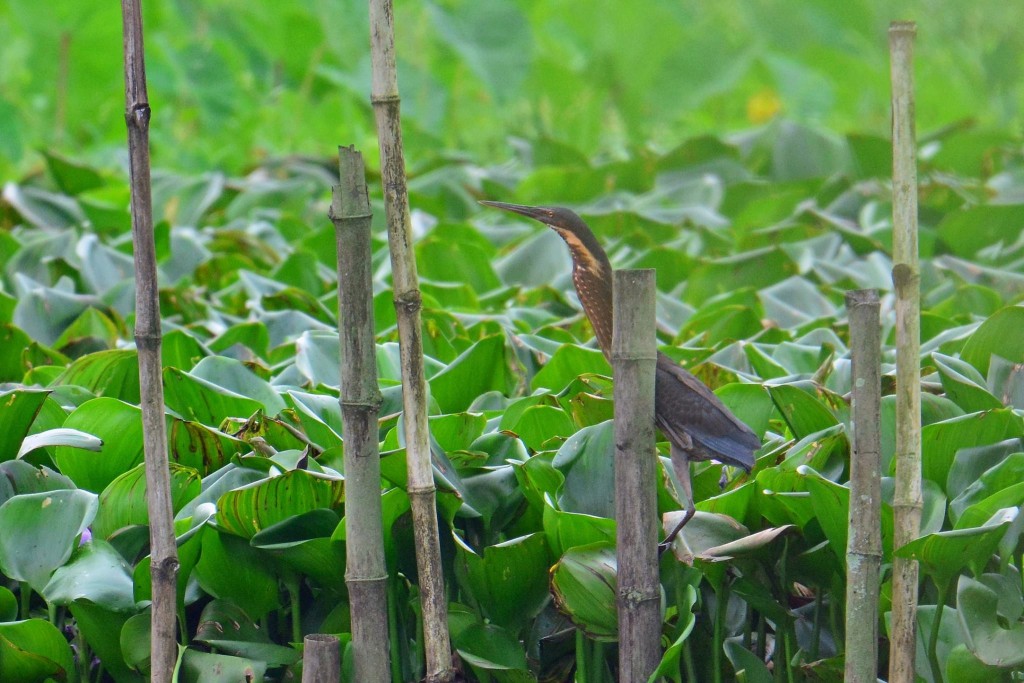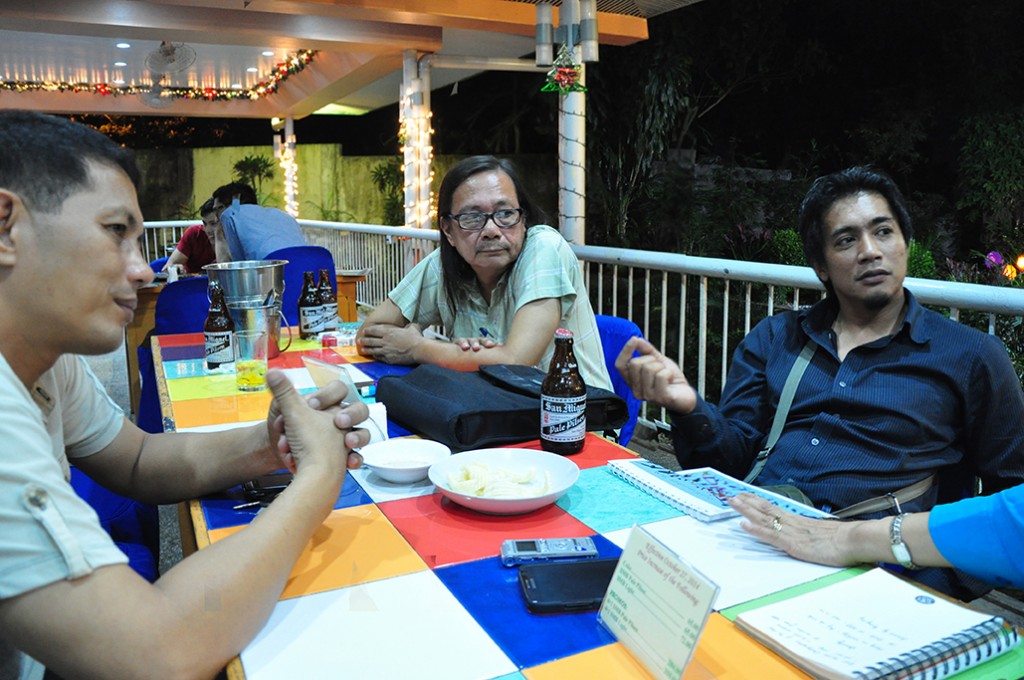By Chi A. Ibay, image by Jefferson Villacruz

(November-December)—On Nov. 9, a post in a social network site on the killing of a bird in the UP Diliman (UPD) campus went viral.
To recap, a Nov. 10 article at GMA News online reported that Amado Bajarias and his wife, Lu-Ann Fuentes, witnessed how the bird—a Black Bittern— was hunted and killed at the lagoon that Sunday afternoon. They posted what Bajarias described as “a senseless act of violence” in their respective Facebook pages.
The couple were members of a birdwatchers club and Bajarias noted that the bird species was “uncommon in the Philippines and extremely rare in the campus.”
The next day, several broadsheets and online news sites picked up the story, further adding debate to what netizens dubbed as “wildlife hunting” on campus.
Rare migratory bird. Three UPD professors, all members of the Wild Birds Photographers of the Philippines (WBPP), say the Black Bittern (Dupetor flavicollis) is present in countries from India to Australia, including the Philippines.
Prof. Norberto Madrigal of the College of Human Kinetics, Dr. Armando Somintac of the National Institute of Physics and poet and playwright Dr. Reuel M. Aguila of the Department of Filipino and Philippine Literature—who call themselves ‘birders’—shared their insights on the incident with UPDate at the WBPP’s night out at the University Hotel days after the unfortunate incident.
According to Madrigal, the species is classified by the book Birds of the Philippines as a migrant resident. He said the species travels to countries close to each other. Because the Philippines is far from its neighbors, it is possible that when the species came to the country, it was not able to travel further.
“Kung maubos sila dito, baka wala na sila,” he noted.
Somintac said he first encountered the species in 2008. He also chanced upon the bird twice before its untimely demise but was not able to photograph it.
Aguila, however, photographed the bird in one of the UP housing sites two days earlier, but he is not sure whether the bird in his photograph was the same bird killed.
It is possible that there are three individual Black Bitterns on campus, Somintac said.
In addition to UPD, the bird can be found in swampy areas in Batangas and in Candaba, Pampanga, Madrigal said but there is very little documentation on the species.

UPD as a bird corridor. More than the killing of the bird, perhaps the most important, yet least known takeaway from the incident is UPD’s unique role as a “bird corridor.”
According to Madrigal, UPD is a part of this corridor because of its trees. The corridor extends from the Sierra Madre mountains to the nearest forest in the La Mesa Dam area which in turn is connected to Balara, Ateneo, Miriam College and UP along Katipunan Avenue. The next area after the UPD campus is the Arboretum and the Ninoy Aquino Parks and Wildlife Center (NAPWC).
“The problem is, the birds need trees to be able to cross to the NAPWC but there is a break so the birds are stopped here,” Madrigal said.
He said there are trees around the College of Human Kinetics and the Asian Institute of Tourism (AIT) across Commonwealth Avenue. When the birds reach AIT, they can proceed to the Arboretum. “The Arboretum is also like an island; when the bird population is depleted, there is nothing else,” Madrigal said.
UPD is a swampland with lots of trees, so there are many kinds of birds on campus such as grassland birds, water birds, canopy birds and forest birds. “Sometimes, these birds should not really be here but they are,” Somintac said.
About 114 bird species have been documented on campus by philosophy professor Agerico De Villa. “He is the first birder at UPD,” Madrigal said. A June 30, 2012 report which featured De Villa at Inquirer.net puts the count at 115.
Madrigal says the number may have increased but the figures remain unofficial since the data is mostly from hobbyists. Today, however, he said there are ornithologists who are undertaking the task.
Birds and buildings. According to the birders, the bird population at UPD is affected by infrastructure projects on campus and along the Katipunan area.
Somintac relates that sometime after a storm in 2008 or 2009, a 3-month old serpent eagle was first seen in the vicinity of Ipil residence hall and eventually wandered around the Beta Way and the street in front of the College of Engineering. It was eventually turned over to the Department of Environment and Natural Resources.
“There was a serpent eagle’s nest in the area of the Metropolitan Waterworks and Sewerage System and it was probably displaced by construction work in the area,” he said. He also noted that there were a lot of birds on campus then.
“When you disturb an area, make plans to rehabilitate it afterwards. For instance, maybe we could ask Ayala to plant trees (around the UP Town Center) and the birds will return, just like what happened at the National Science Complex. When the buildings were under construction, there were no birds in the area. Now, they have returned,” Somintac said.
“The replanting should restore the food, water and shelter needs of the birds,” Madrigal said. He cautions about converting the replanted area into a park for people. “I wish they would maintain the area as a mini forest where there are areas that are clean and areas where there are plants with undergrowth and normal decay,” he said.
Madrigal proposes plants of differing heights for different kinds of birds. “There are birds in tree canopies, some are in the middle and there are also birds that only stay on the ground and these do fly very far,” he said.
Over-maintained grounds are also not conducive to birds and other wildlife. “The bird population decreases when UPD grounds are too clean,” Somintac noted. “Don’t cut the grass too much: leave a little overgrowth. When you trim the grass to the ground, there are no safe areas for wildlife and they will move to another place,” he said.
Birds and the environment. The birders are pushing to use bird species and population as indicators of the health of an environment.
The Maya is a good indicator of the state of an environment. “Maya birds are scavengers and when there are a lot of them, that means the environment is not clean,” Madrigal said.
There are no Mayas in the forest, Somintac said, but there are a lot in cities. The Crow is a similar indicator. “Where there are Crows, there is garbage,” Madrigal added.
Somintac said UPD is still a healthy environment, and the lagoon is a wildlife habitat because it is a source of food and water, even in the summer.
UPD’s wildlife policy. The main issue raised by the couple who posted the incident was the need “to protect more effectively the wildlife that seek shelter in its grounds.”
According to Aguila, he proposed to declare UPD as a bird sanctuary in October 2013, when he curated the photo exhibit Bagwis: Birds of UP Diliman at the University Theater. The exhibit featured the avian treasures on campus as captured by 10 photographers, mostly birders.
He was then informed that UPD had already been declared a bird sanctuary but he could not say who made the declaration.
“The problem is, is this declaration being implemented?” he asked.
Even without the declaration, there is a wildlife act that prohibits the killing of birds in the country, Somintac pointed out. He said what is needed is to educate more people on the matter.
He was referring to Republic Act No. 9147 or the “Wildlife Resources and Conservation Act,” which prohibits the killing of birds and wildlife that Vice Chancellor for Community Affairs Nestor Castro cited in a Nov. 11 statement condemning the incident.
Aguila however thinks the issue is more of security on campus. “The issue I raise with the Black Bittern is why non-UP people are allowed to roam on campus openly carrying an ‘itak’,” he said, which is a different story altogether.
